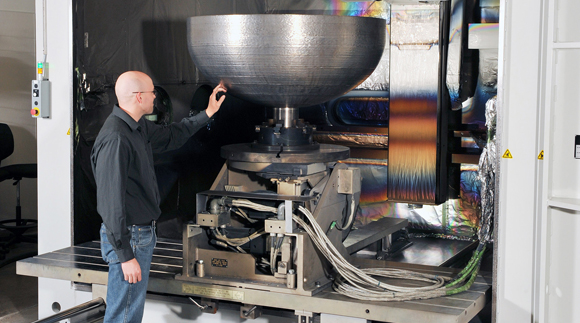EBAM satellite fuel tank domes ‘largest additively manufactured parts in space’
July 23, 2018

A Lockheed Martin engineer inspects one of electron beam additively manufactured dome prototypes at the company’s space facility in Denver. The final dome has a diameter of 116 cm (Courtesy Lockheed Martin)
Sciaky, Inc., Chicago, Illinois, USA, a subsidiary of Phillips Service Industries, Inc. (PSI), has achieved qualification of its Electron Beam Additive Manufacturing (EBAM) process for the production of titanium domes for satellite fuel tanks through the completion of testing by Lockheed Martin Space, Denver, Colorado, USA. The 116 cm (46 in) diameter vessels will reportedly be ‘the largest additively manufactured parts in space’, and completed the final round of quality testing this month, ending a multi-year development program to create very large, high-pressure tanks used to carry fuel on board satellites.
Satellite fuel tanks must be both strong and lightweight to withstand the rigors of launch and decade-long missions in the vacuum of space, with even very small flaws or leaks catastrophic for the satellite’s operations. These new titanium fuel tanks consist of three parts welded together: two EBAM domes which serve as caps, plus a variable-length, traditionally-manufactured titanium cylinder which forms the body.
To complete the qualification, Lockheed Martin Space additively manufactured both halves of the titanium fuel tank domes on a Sciaky EBAM 110 machine at its Denver facility. During testing, the tanks are said to have met or exceeded the performance and reliability required by NASA, enabling them to become a standard product option on LM 2100 satellites.
Sciaky’s EBAM systems can produce parts ranging from 20 – 580 cm (8 – 228 in) in length, with gross deposition rates ranging from 3.18 – 11.34 kg (7–25 lbs) of metal per hour. Using conventional manufacturing methods, a satellite fuel tank – comprising a four-foot diameter, four-inch thick titanium dome – could take more than a year to deliver, but Lockheed Martin stated that Sciaky’s EBAM technology reduced the production time dramatically for the domes as well as reducing material waste during manufacture.
“Our largest 3D printed parts to date show we’re committed to a future where we produce satellites twice as fast and at half the cost,” stated Rick Ambrose, Lockheed Martin Space Executive Vice President. “And we’re pushing forward for even better results. For example, we shaved off 87% of the schedule to build the domes, reducing the total delivery timeline from two years to three months.”
“These tanks are part of a total transformation in the way we design and deliver space technology,” he continued. “We’re making great strides in automation, virtual reality design and commonality across our satellite product line. Our customers want greater speed and value without sacrificing capability in orbit, and we’re answering the call.”
“Sciaky’s EBAM technology is now the world’s only large-scale metal 3D printing process that has qualified applications for land, sea, air, and space,” added Scott Phillips, President and CEO of Sciaky. “We are delighted to work with the innovators at Lockheed Martin Space and will continue to push the boundaries of Additive Manufacturing.”
















